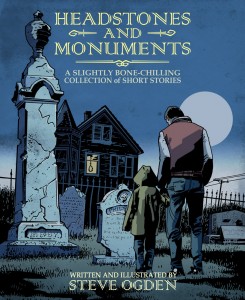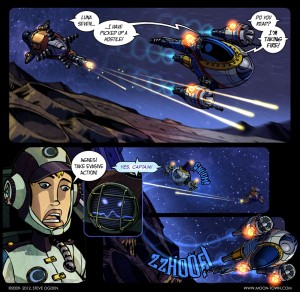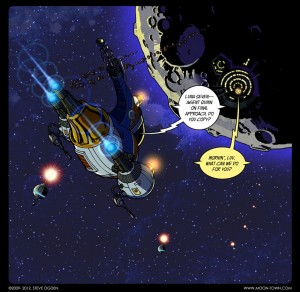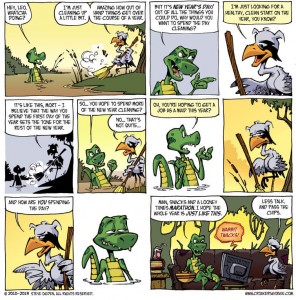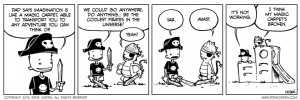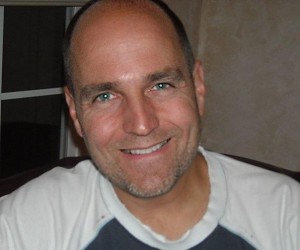 Steve Ogden is a writing and drawing machine. Steve is the creator of the on-line graphic novel “Moon Town”, two comic strips “Croakers Gorge” and “Silas and Max” and has published a book of bone chilling short stories called “Headstones and Monuments”. Steve has done all of this while working intense hours in the video game industry, raising three children with his wife and staying fit by running 3-5 miles most days (that’s a pretty hectic schedule). This week at Don’t Pick the Flowers I’m happy to talk with Steve Ogden as he discusses his life, art and what we can expect to see from this super talented creator.
Steve Ogden is a writing and drawing machine. Steve is the creator of the on-line graphic novel “Moon Town”, two comic strips “Croakers Gorge” and “Silas and Max” and has published a book of bone chilling short stories called “Headstones and Monuments”. Steve has done all of this while working intense hours in the video game industry, raising three children with his wife and staying fit by running 3-5 miles most days (that’s a pretty hectic schedule). This week at Don’t Pick the Flowers I’m happy to talk with Steve Ogden as he discusses his life, art and what we can expect to see from this super talented creator.
David: Hi Steve, Thank you so much for being featured at Don’t Pick the Flowers. You have an impressive amount of work. To start with, you have been drawing and writing all your life but what are the things that started you down the creative road? Who are the artists/cartoonists and writers that influenced you the most?
Steve: What sent me down the road to drawing was primarily my Dad. When I was a little kid, any time I was bored, he’d say, “Why don’t you draw something?” And I was bored a lot, so I drew a lot. Of course, he also sent me outside to run a lot, or to muck the stables (we lived on a farm in Virginia with 70 horses). The running and the drawing stuck. The stable mucking – not so much.
I started drawing comics when I was about 8 years old. I started by copying Superman and Batman off of afterschool cartoons. I would draw them from the back, so they were usually just a triangular cape with heads poking out the top and feet poking out the bottom coz I couldn’t draw that well. And I read a lot of stuff. Peanuts collections, old Spider-Man. I learned a lot about drawing comics by tracing Joe Sinott’s work.
I’m honored that I got to read some honest-to-God Jack Kirby first runs. I liked his Fantastic Four and Thor. I didn’t understand what he was doing – I remember thinking incorrectly that he must not be able to draw very well – but that stylistic approach has always stuck with me. Later, I became an X-MEN fan. John Byrne, and specifically Terry Austin as an inker. In fact, it wouldn’t have been surprising if I’d become a professional comics inker, I admired Terry so much, and learned so much about quality of line and spread of detail from his work. After him, Michael Golden, Barry Windsor-Smith, Walt Simonson and Art Adams were my idols. There are aspects of my drawings you can trace back to all those guys.
I stopped reading comics around 20 years old, mid college, when I tried to get a job at Marvel comics as a penciler or inker. My dad was working on the 52nd floor of the Empire State Building by that point, and it seemed like a natural opportunity for me to intern at Marvel. Turned out I didn’t have the talent they were looking for, and I decided there was no future in comics for me. I found work as a freelance illustrator, and not long after that, a home in the computer game industry, and it’s been home ever since.
Flash forward 20 years. When I was 40, I found Kazu Kibuishi’s Flight comics anthologies in a local comic store and realized there was a lot more to comics than superheroes. And I found Mike Mignola’s Hellboy at the same time, and I have found it very hard not to work on comics ever since. It’s like some terrible compulsion!
David: With so many projects you are working on, what’s it like in “the day in the life” of Steve Ogden? Do you have a set schedule, and how do you start your creative day? And with that, what are the tools you work with and your favorites?
Steve: My day job for the past 10 years has been making games at Firaxis (Civilization, Pirates, X-COM). It’s great work, but you never know when you’re going to work a bit of overtime. So, with a wife and three sons and a job that can be a lot more than full time, “spare time” is a rare commodity and I have found that I can’t commit a given number of hours to my extracurricular art, can’t make promises to my audience. I’ve tried to keep an update schedule and it’s just been disappointing for my readers, and frustrating for me. So, I’m trying to be more at home with working on one of my properties when I can, and updating my websites when I can, and just let the fans fall where they will. Some of them get angry and leave when you can’t keep a schedule, some will stay no matter what, and some are more casual about it all and just come check it out when there’s something to see.
My schedule on a good day starts at 6AM, helping get the kids out the door to school. After breakfast, I check email, maybe post a few things on Facebook or Twitter, and get ready and go off to work. I’m currently the Studio Art Director at Firaxis, which means I manage around 55 artists, animators, writers, level designers and audio designers on a variety of video game projects. I also occasionally work on assets for the games. It’s not as much as I used to, but I do try to keep my hand in it.
After work, it’s dinner, afterschool sports with the kids. Exercise – I try to find time to run 3-5 miles most days. Then, it’s helping with homework. Afterward, a quick check on my work email, try to fix anything that might have slipped through the cracks. Around 10PM, it’s “my” time. Dinner dishes are done, everyone’s heading off to bed, my wife is starting to settle down for the night. I hit the computer and draw or write or color or post new comics.
As for tools, I use Microsoft Word and Google Docs for writing. I write in my head in the car on the way to and from work, and write it all down later. And I used to pencil and ink the strip traditionally on actual paper, using a light box to trace the Ticonderoga #2 pencils and ink it up with Microns and Brush pens. I’d scan those inks and then work in Photoshop to blackspot and color the whole thing up. These days, I work all digitally. For 5 years, I saved up for a Cintiq – I have one at work and it’s proved to be indispensible – and Santa Claus brought me one for Christmas this past year.
It’s really made me much more productive. I can ink in a fraction of the time and there’s a lot less jiggery-pokery of drawing and tracing and scanning. When I start a page now, I’m working in the final Photoshop document. I lay it out, I letter it, I do rough breakdowns (“pencils”) and then “ink” over that on another layer, and then color it, and then do dialog balloons around any final text edits, and then add some watercolor textures to break up the big, flat areas of digital color, and boom. 4-8 hours later, a new Moon Town page!
I work like this until 12 midnight or 1AM pretty much every night and any free time I can get on weekends, and then get up and do it all again the next day. I try to balance everything, but there’s a lot to balance. Most days I go to bed feeling like I haven’t done enough, not for me, not for the job, not for the family. I’m not sure I’ll ever get it right.
David: You released a book this past year called “HeadStones and Monuments”, can you talk a little about the short stories and has this been something you’ve been working on for some time?
Steve: A friend of mine got me hooked on Stephen King and Neil Gaiman a few years ago. I think Headstones and Monuments is the direct result of that, and specifically Gaiman’s collection of short stories, Fragile Things.
I don’t know – I have been toying with the idea of releasing “text novels” (as opposed to graphic novels) for several years now. I have several ideas in various stages of production, but it’s hard to keep my motivation up for these long stories, these extremely long projects, with the occasional lapses into Crunch Time at work. Any interruption in a long-term endeavor like that can knock you off course, and it’s happened again and again. But when I read Gaiman’s Fragile Things, it occurred to me how much you could say with short stories. It also occurred to me that if I worked on a collection of short stories, I could probably get them done quickly, and even if I got into a bit of Crunch, I could still come out the other side and get more of them done. It was a sort of log jam I had to break up. Now that I’ve finished and released that book, I so want to do more. It’s as addicting as potato chips – you can’t just do one.
The stories themselves are a mixed bag. “Monuments” is about me when I was young, living in a house across from a scary old farmhouse in Pennsylvania. I saw stuff as a little kid that couldn’t be explained. I almost died on a road right behind my house twice – once getting thrown through a windshield of my mom’s car. “Headstones” is about the farm I grew up on in Virginia, and everyone who lived there or ever visited me there swears the old house was haunted. It surely was.
The rest of the book – there are a couple of Autumnal poems as sort of lyrical palate cleanser, and a few other stories. “Sequitur” is about a guy who has to face a ghostly reality at Gettysburg. “Muse” is about a little girl fighting for her life and the lives of her classmates when a demon comes to visit her music class. And “Visited Upon the Sons” is a pretty involved, multi-generational ghost story about kids who break into a haunted house and have to deal with the terrifying ramifications when they grow up and find their children threatened by dark forces.
It’s been well-received. It’s more creepy than terrifying, the sort of thing that leaves you looking over your shoulder when you are heading upstairs after turning out the lights late at night. Any fans of Stephen King or Neil Gaiman would probably like this book.
David: Your online Graphic Novel “Moon Town” was voted Best Webcomic in 2009 by The Webcomic List and Best Online Graphic Novel in 2011 by Baltimore Magazine.What was the inspiration behind Moon Town and what would you like to see in the future with this story (or better yet what can we expect to see)?
Steve: Moon Town was originally a little animated film I wanted to make in my spare time. At some point I realized that I just didn’t have the time to do it in the rich style I so loved (early Pixar – charming, and pure gold). So, I decided to do it as a comic, instead.
As for the future of Moon Town, I’m currently re-installing it online after I took it down early last year in a fit of frustration. I’m taking some of the original pages I did from 2009-2011 and I’m changing some things I didn’t like. There were narrative bits that made no sense, and although I am pretty decent at drawing machines, the humans have been a bit all over the map with regard to “staying on model”, which is nice way of saying I didn’t always draw them so that they looked like themselves. So, I’m re-drawing portions of the comic, making a few new pages in light of some story changes, and adding some textures to the colors. A lot of subtle changes, but they all add up to professional quality polish and a better reader experience, or at least so I hope.
Once I work through my corrections on the first 40 pages or so (the contents of the first Moon Town book I originally released in 2010), I’ll begin some pretty extensive work that will change what people knew of Moon Town’s next 40 pages. All of this is building toward a graphic novel some time in the next couple of years. It will be around 160 pages long, assuming I don’t get knocked off track by my Regular Life. You know, that balance thing. But I’m anxious to tell the rest of this story and let people read it.
I will probably stop putting new Moon Town pages up online at some point, and just work in private, release the book when it’s done. There’s something in me that doesn’t think it’s a good idea to show the whole book online for free when I’m hoping to sell a book at the end of this, but I am keeping my eye on the market. Others have had some success following that model, notably Jason Brubaker of reMIND and Doug TenNapel with Ratfist. I could do worse than follow their lead.
Narratively, the first 40 pages of Moon Town are all about asking questions, and I don’t want to be guilty of the sins of LOST. Sooner or later, you have to start satisfying people’s curiosity, so you can look for some answers in the Moon Town universe over the next 40 pages or so. Not all answers, mind you, and of course there will be new questions. But we’ll find out more about those little Kokopelli Rabbit creatures – just what are they? – we’ll find out what’s going on with Vin Sinclair. And we’ll see Simon take a little more control over his life. He’s been drifting for a few decades, and the events that have been unraveling are just the sort of wake-up call a man like him needs.
David: Two other comics you work on are “Croakers Gorge” and “Silas and Max”. Can you talk about these comics and what are your goals with them?
Steve: One influence I didn’t name in my earlier answer was Bill Watterson’s Calvin and Hobbes. I love that strip, and Bill’s lines taught me as much about inking as anyone else.
Croaker’s Gorge is a strip I tried to get picked up by several syndicates in the early 1990s, but no one was biting. It ran in a couple of small, local papers you could pick up for free in the late 90s, and in an Italian comics supplement (yes, translated into Italian) in the early 2000s. I finally put it up online in 2008, and I occasionally go back in and tinker with the old strips, adding color, or reworking a joke. And occasionally I make new strips, but they’re bigger now. More like a Sunday newspaper strip, longer, more room to tell a more complex joke, and in color.
I don’t think there is any publication future for Croaker’s aside from the books I’ll produce myself. 20 years of chasing that ship has to teach you something. But the strip is important to me. It owes a lot to my upbringing – I was a little kid that moved from the suburbs to a farm and spent a lot of time alone with animals that I imagined could talk to me – and it has a bit of an environmental edge to it, which I felt elevated it to something more than just a strip. There’s some Pogo in Croaker’s Gorge, buried down deep. You can see it along with Watterson (and MacNelly’sShoe) in the best of the Croaker’s strips.
Silas and Max is much newer. It is a direct result of my soul yearning for more Calvin and Hobbes, when we all know there won’t be any more. It’s not that I’m setting out to re-create that strip, but it definitely scratches the same itch in me. Every time I create a Silas and Max strip that I feel works, it gives me that warm feeling like it’s 1986 and I’m reading Calvin and Hobbes on the floor in my parents’ house. There’s a bit of magic there. Maybe I’m just trying to capture a little of that lighting in a jar.
As for my goals with Silas and Max? If I could have anything in the world for Silas, it would be to get it syndicated. I have written a few more strips that are promising and I will draw them up eventually and see if I can get anyone’s attention with it. I’ve had people tell me it’s idiotic to try to get a comic syndicated right now when the conventional wisdom says that newspapers are going the way of the Dodo. And I can see that and most days, that logic directs me to more time worthy pursuits. But the romantic in me thinks otherwise. If we’re all getting ready to turn out the lights on dead-tree pulp-printed newspapers, wouldn’t it be fitting if an heir to Calvin was in those pages as we turn out the lights? Besides, newspapers will go on, though they will change, and I expect comics, or something comic-like, will always accompany the news. I’d love to be part of that. I’d love to provide that kind of entertainment for people, like I was entertained as a kid.
Thank you for featuring me. It’s amazing that you take time out of your insanely busy schedule to interview other artists, and I’m honored to be included.
David: Thank you Steve for being featured and taking the time to share your work, you are a real champion with time and I applaud you! You are a fantastic creator and I look forward to the results of all your hard work.
And for all the fans and those discovering Steve Ogden and his art click on the links below to avail yourself to Steve’s incredible creations.
Steve Ogden Website: www.steveogden.com
Croackers Gorge: steveogden.com/croakers
Moon Town: steveogden.com/moontown
Facebook: www.facebook.com/SteveOgdenArt
Twitter: twitter.com/SteveOgdenArt
Headstones and Monuments: www.amazon.com/dp/B009Z645DI

